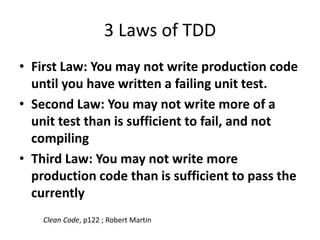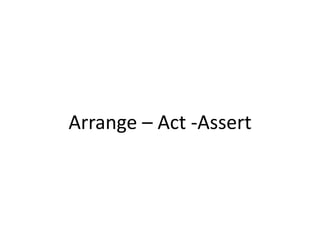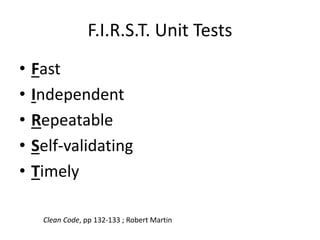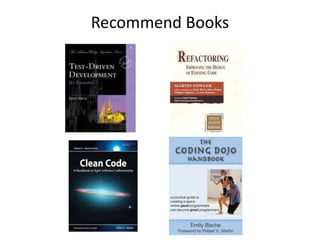Coding dojo - TDD
- 1. Coding Dojo - TDD Basics Steve Zhang
- 3. 3 Laws of TDD • First Law: You may not write production code until you have written a failing unit test. • Second Law: You may not write more of a unit test than is sufficient to fail, and not compiling • Third Law: You may not write more production code than is sufficient to pass the currently Clean Code, p122 ; Robert Martin
- 4. Arrange – Act -Assert
- 5. Fake It! • Fake it till you make it • Triangulation
- 6. “As the tests get more specific, the code gets more generic.” - Uncle Bob
- 7. Refactoring • Change code without changing its behavior • Refactoring != Redesign • Remove the Fake • Remove Duplication • Refactor both test code and production code
- 8. F.I.R.S.T. Unit Tests • Fast • Independent • Repeatable • Self-validating • Timely Clean Code, pp 132-133 ; Robert Martin
- 9. Test Methods • Single assert • No conditional logic • Standard format – Setup – Exercise – Verify – Teardown
- 10. Recommend Books
- 11. Let’s Start! • Kata: StringCalculator • Test method Example add_With_Empty_String_Returns_Zero()
Editor's Notes
- Arrange all the things needed to exercise the code Act on the code you want to verify Assert that the code worked as expected
- Robert Martin “uncle bob” OO design guru - S.O.L.I.D. principles One of 17 formulator’s of Agile manifesto. Manifesto his idea One founder of “Craftsmanship” movement. Manifesto for Software Craftsmanship. Fast Must be able to run quickly. <10 minutes ideal Independent No test should depend on another. Order should not matter. Repeatable Should be able to run them at any stage, development, QA, production Timely - Created with code
- Having a single assert is an ideal. The idea is that the test should test ONLY ONE THING. In practice you might find a couple of asserts are needed, but try to keep it to one.











